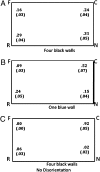Impaired geometric reorientation caused by genetic defect
- PMID: 20133673
- PMCID: PMC2840366
- DOI: 10.1073/pnas.0909155107
Impaired geometric reorientation caused by genetic defect
Abstract
The capacity to reorient in one's environment is a fundamental part of the spatial cognitive systems of both humans and nonhuman species. Abundant literature has shown that human adults and toddlers, rats, chicks, and fish accomplish reorientation through the construction and use of geometric representations of surrounding layouts, including the lengths of surfaces and their intersection. Does the development of this reorientation system rely on specific genes and their action in brain development? We tested reorientation in individuals who have Williams syndrome (WS), a genetic disorder that results in abnormalities of hippocampal and parietal areas of the brain known to be involved in reorientation. We found that in a rectangular chamber devoid of surface feature information, WS individuals do not use the geometry of the chamber to reorient, failing to find a hidden object. The failure among people with WS cannot be explained by more general deficits in visual-spatial working memory, as the same individuals performed at ceiling in a similar task in which they were not disoriented. We also found that performance among people with WS improves in a rectangular chamber with one blue wall, suggesting that some individuals with WS can use the blue wall feature to locate the hidden object. These results show that the geometric system used for reorientation in humans can be selectively damaged by specific genetic and neural abnormalities in humans.
Conflict of interest statement
The authors declare no conflict of interest.
Figures


References
-
- Cheng K. A purely geometric module in the rat’s spatial representation. Cognition. 1986;23:149–178. - PubMed
-
- Gallistel CR. The Organization of Learning. Cambridge, MA: MIT Press; 1990.
-
- Hermer L, Spelke E. Modularity and development: the case of spatial reorientation. Cognition. 1996;61:195–232. - PubMed
-
- Hermer L, Spelke ES. A geometric process for spatial reorientation in young children. Nature. 1994;370:57–59. - PubMed
-
- Learmonth AE, Newcombe NS, Huttenlocher J. Toddlers’ use of metric information and landmarks to reorient. J Exp Child Psychol. 2001;80:225–244. - PubMed
Publication types
MeSH terms
Grants and funding
LinkOut - more resources
Full Text Sources

